Is your e-commerce store struggling to gain traction in Google? You’re not alone.
The SEO landscape has evolved dramatically in recent years. The days when you could rank at the top of Google simply by adding keywords to title tags and meta descriptions are long gone. Google has released dozens of algorithm updates that most businesses—and even many SEO agencies—haven’t fully adapted to yet.
The good news? Once you identify and fix these issues, your site can experience remarkable growth.

Let’s dive into the 11 critical SEO mistakes that might be costing you thousands in lost revenue every month—and more importantly, how to fix them.
Mistake #1: Focusing on the Wrong Part of the Funnel
Many e-commerce sites make the fundamental mistake of targeting keywords from the wrong stage of the customer journey.
The typical customer journey consists of three stages:
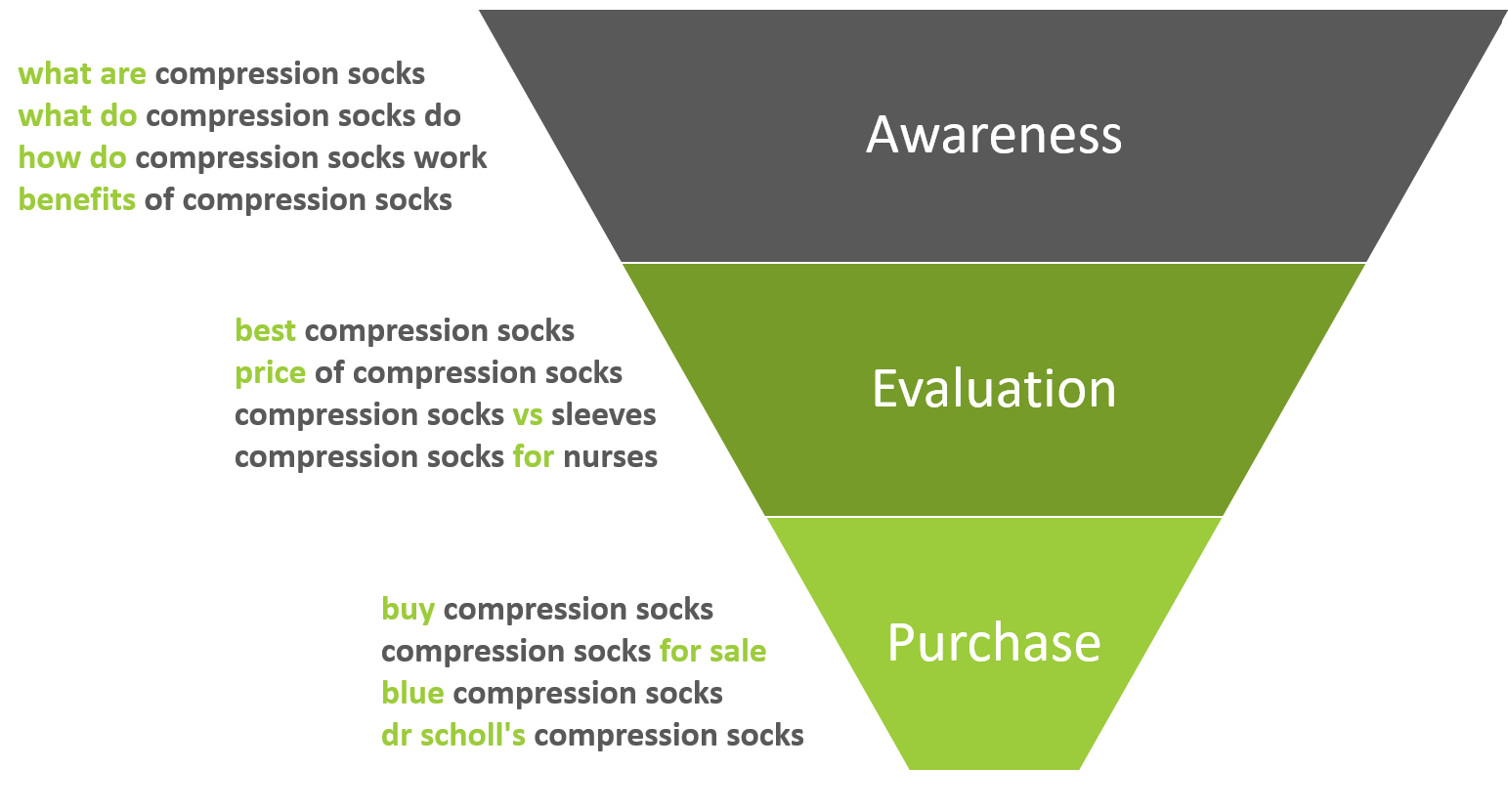
A common mistake is focusing too heavily on awareness-stage keywords. While these terms typically have higher search volumes and lower competition, they rarely drive actual revenue since these searchers aren’t ready to buy just yet.
Instead, prioritize Evaluation-stage keywords for your blog posts and Purchase-stage keywords for your category and product pages
This targeted approach ensures you’re not just driving traffic, but also generating revenue from your SEO efforts.
Mistake #2: Targeting Overly Competitive Keywords
Many store owners make the mistake of targeting broad, high-volume keywords without considering the competition level.
Let’s compare two search terms:
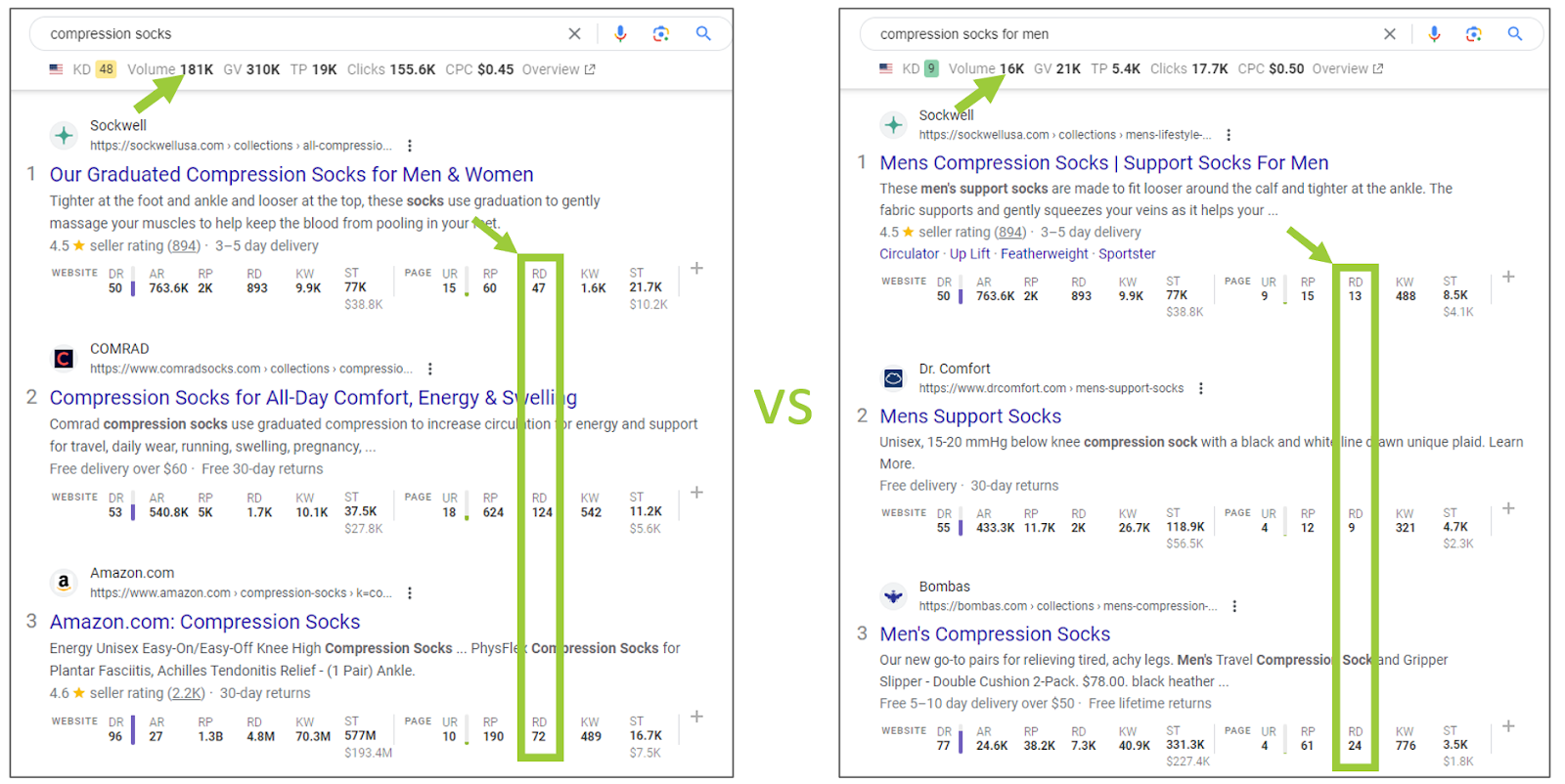
The keyword “compression socks” has 10x more search volume than “compression socks for men”. Many business owners will put too much focus on search volume and go all in on the keywords with the most search volume.
In the world of SEO we assess competition by looking at how many sites are linking to the top rankings pages (not the entire domain). From the screenshot above, you can see that the pages ranking in the top 3 position for “compression socks” have around 50-120 backlinks each, while those ranking for “compression socks for men” only have 10-20 backlinks.
So in this case, we would only need around 10-20 backlinks to rank for “compression socks for me”, making it a much more viable keyword since it’s so much easier to rank for.
The lesson? Sometimes it’s better to target less competitive, more specific keywords first. You’ll rank faster and start generating revenue sooner, rather than spending months and months fighting for highly competitive terms with no immediate results.
Mistake #3: Category Pages Lacking Sufficient Content
Many e-commerce stores have category pages with minimal or no content—just a grid of products with perhaps a short heading.
Consider this real example: For the keyword “freestanding bathtub” (4,400 monthly searches), a major brand like Kohler ranks only in position #8.
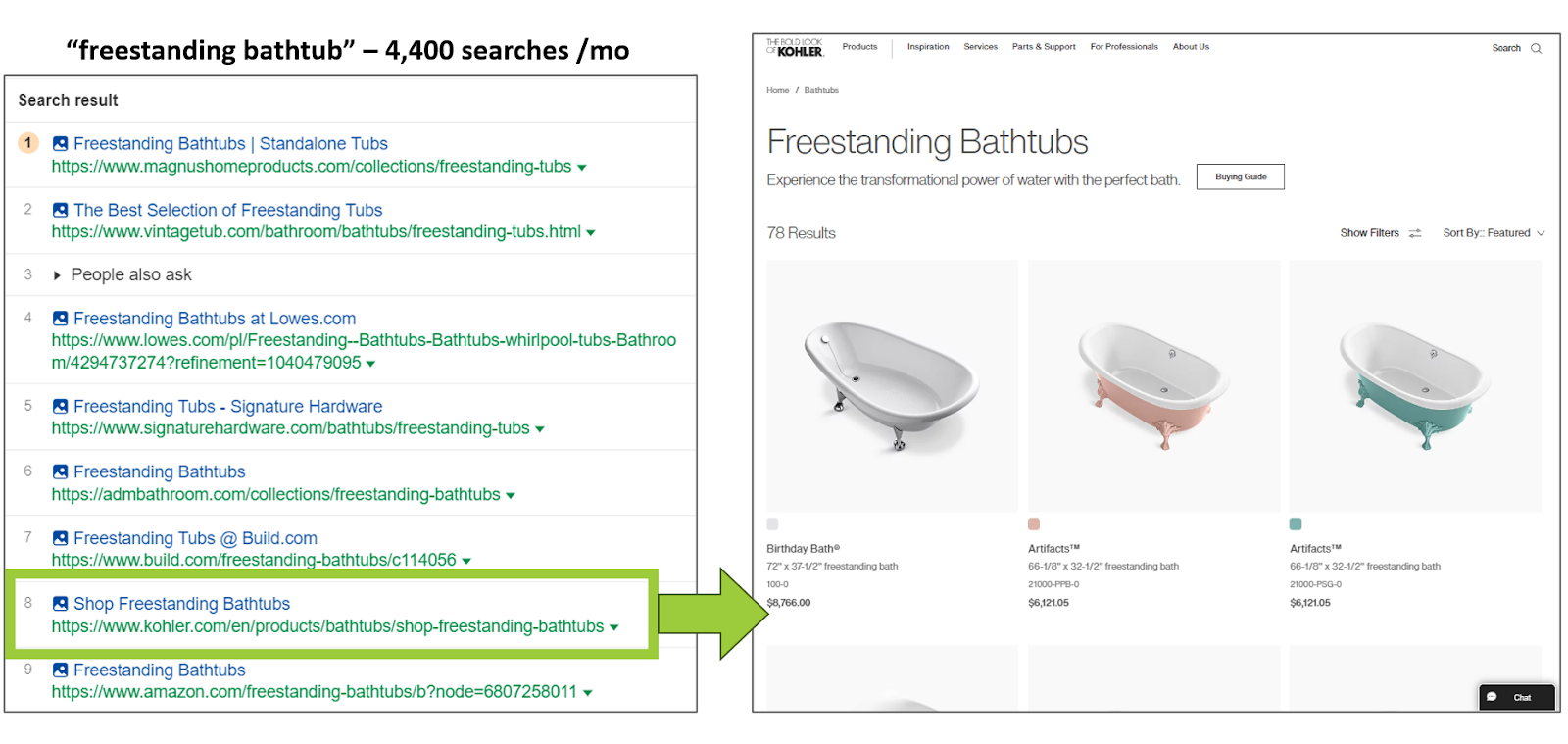
How could this be?
Well it’s most likely because they don’t really have any content on the page, just a short sentence at the top.
Meanwhile, Magnus Home Products ranks #1, partly due to their a robust category description that explains:
- Why customers should choose their products
- Key features and benefits
- Helpful information for making purchase decisions

Google rewards pages that provide genuine value to users, not just product listings. Adding just 200-300 words of helpful, informative content to your category pages can significantly boost their ranking potential.
Mistake #4: Not Using Related Keywords in Content
When Google crawls a page, it needs context to understand what the page is truly about.
For example, if a page is titled “Top 10 Shades for Sale,” how does Google know if it’s about window shades or sunglasses?

The answer: Google relies on the related keyword to better understand the page and its context.
A page about window shades would naturally include terms like:
- living room
- pull down
- wood
- roller
- motorized
A page about sunglasses would include terms like:
- Ray-Ban
- polarized
- Aviator
- men’s
- women’s
Not sure which keywords to use in your content? You can search for your keyword into Google Image Search and look at the refinement bar at the top—these are excellent related keywords to incorporate into your content.
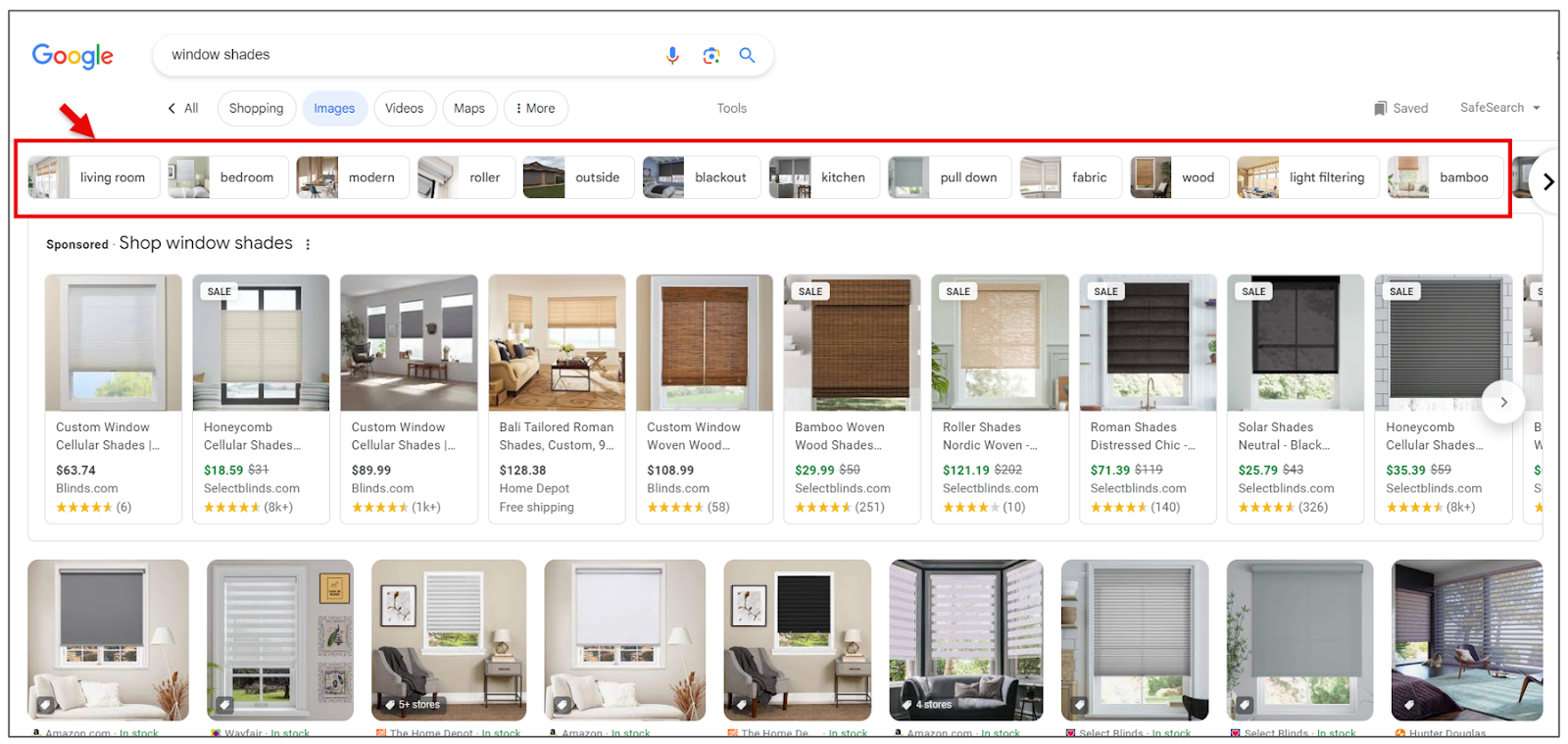
Mistake #5: Content is Too Fluffy and Lacks Substance
Even if you’ve added content to your category pages and used related keywords, you might still struggle to rank if your content is “fluffy” and lacks substance.
Here’s an example from an actual category page we discovered when working with a client:

Take a look at the description. The content is wordy, generic, and provides very little valuable information to help customers make a purchasing decision.
Instead, your content should answer questions like:
- Why are your products better than competitors’?
- How should customers choose between different options?
- What materials are used in your products?
- What makes your products high-quality?
Google’s advanced natural language processing can detect fluffy content just as easily as humans can.

In fact, Google has a patent for “information gain score” which evaluates how much useful information a reader can extract from content.
A shorter, information-dense 200-word description can outperform a 500-word fluffy description if it provides more value to the reader. Focus on substance over word count.
Mistake #6: Pages Cannibalizing Each Other
Keyword cannibalization occurs when multiple pages on your site target the same keywords, causing Google to struggle with determining which page to rank.

A case study with Sports Gear Swag illustrates this problem perfectly. They had three different types of pages that could potentially rank for “custom basketball uniforms”:

- Parent Category – A general basketball category page with all basketball products
- Subcategory – A basketball custom uniforms subcategory page
- Products – Individual basketball uniform product pages
As a result, their rankings constantly fluctuated between these pages, and they couldn’t break into the top 20 search results.
The solution?
- We identified which page provided the best user experience for the term (the subcategory page)
- We reoptimized the Custom Uniforms subcategory page specifically for the target keyword
- We used internal linking to signal to Google which page should rank by linking from the main category page to the subcategory page, and from product pages to the subcategory page through breadcrumbs.
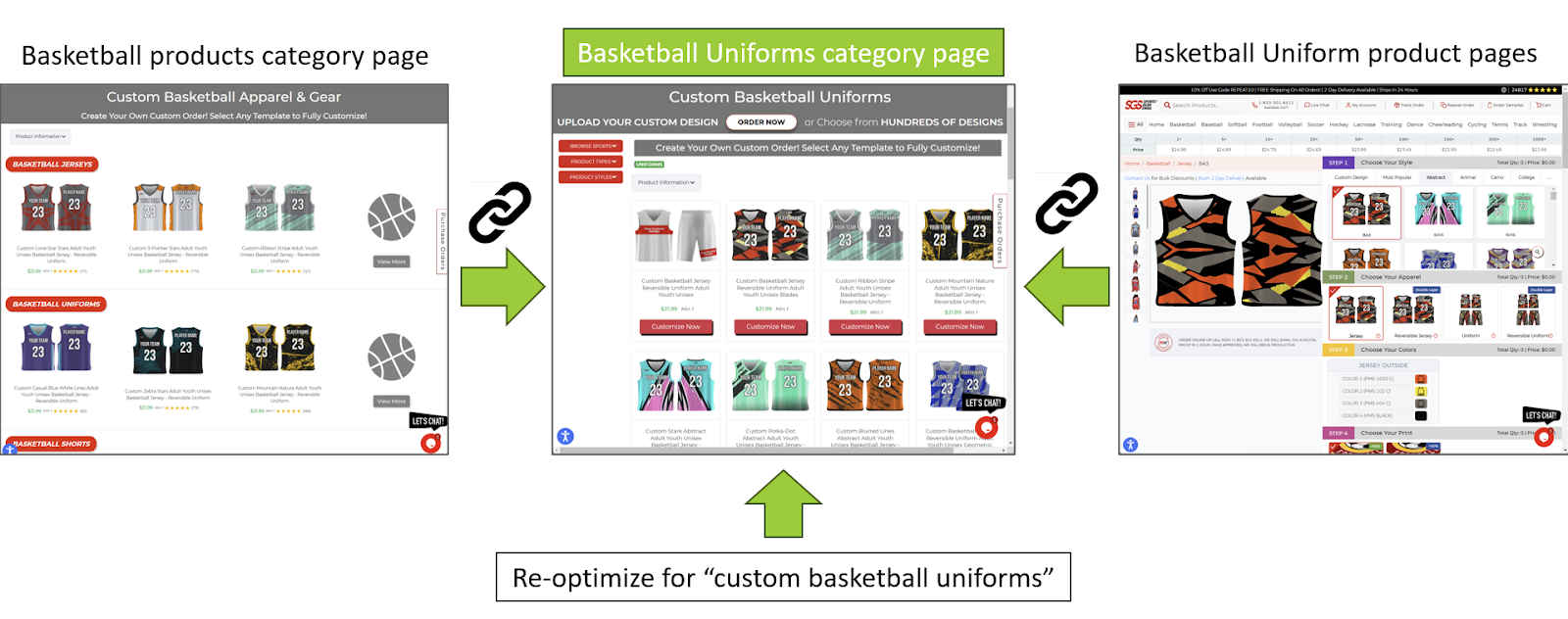
As a result, their rankings steadily climbed until they reached position #1.
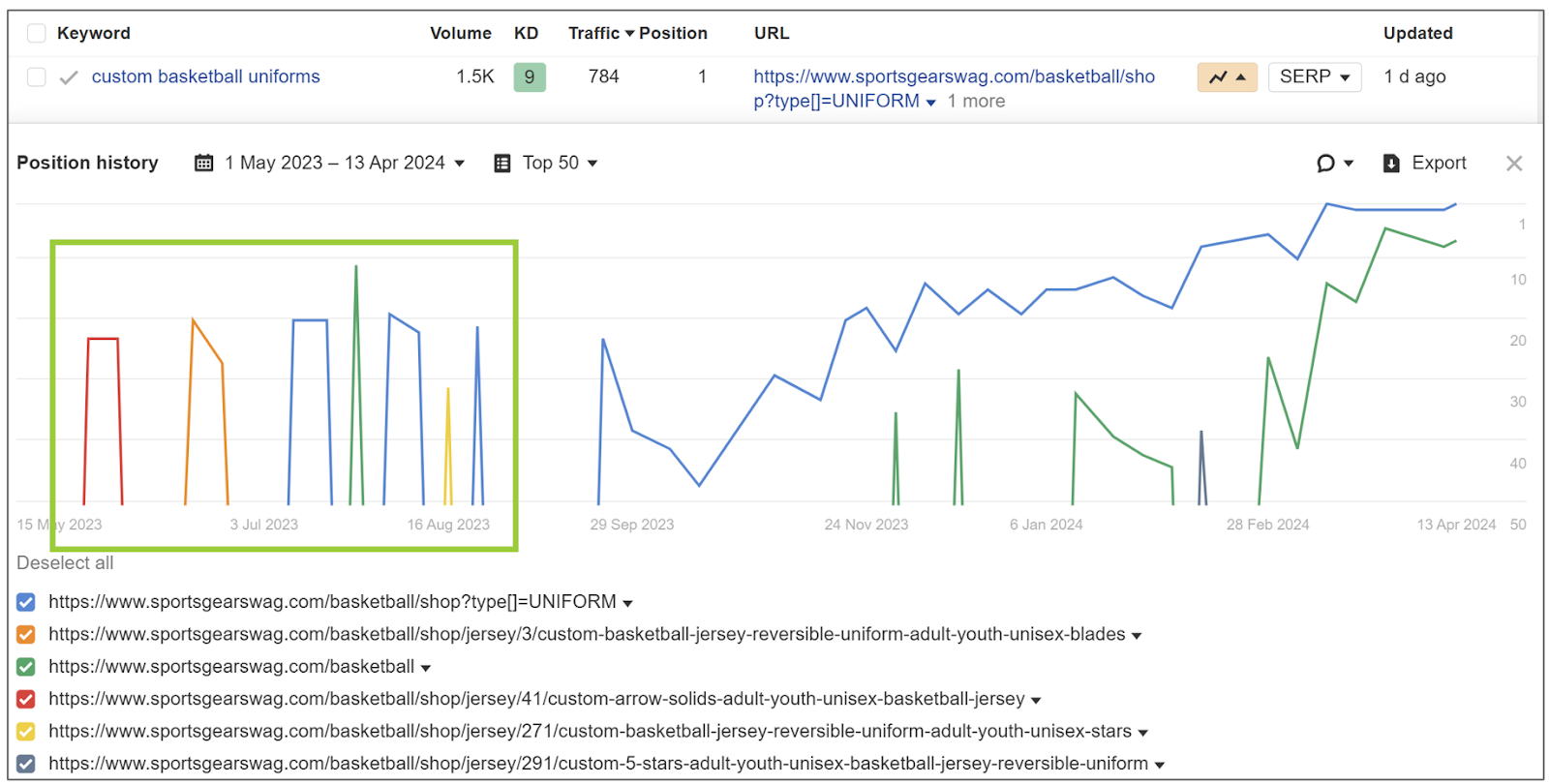
Mistake #7: Product Catalog is Too Big
A leaked Google document revealed that Google uses a ranking factor called “site focus score—a metric indicating how hyperfocused a site is on a particular topic.
In practice, this means:
- A site selling everything will be outranked by a site that just sells phone accessories
- A site selling phone accessories will be outranked by a site that just sells phone cases
- A site selling phone cases will be outranked by a site that just sells iPhone cases
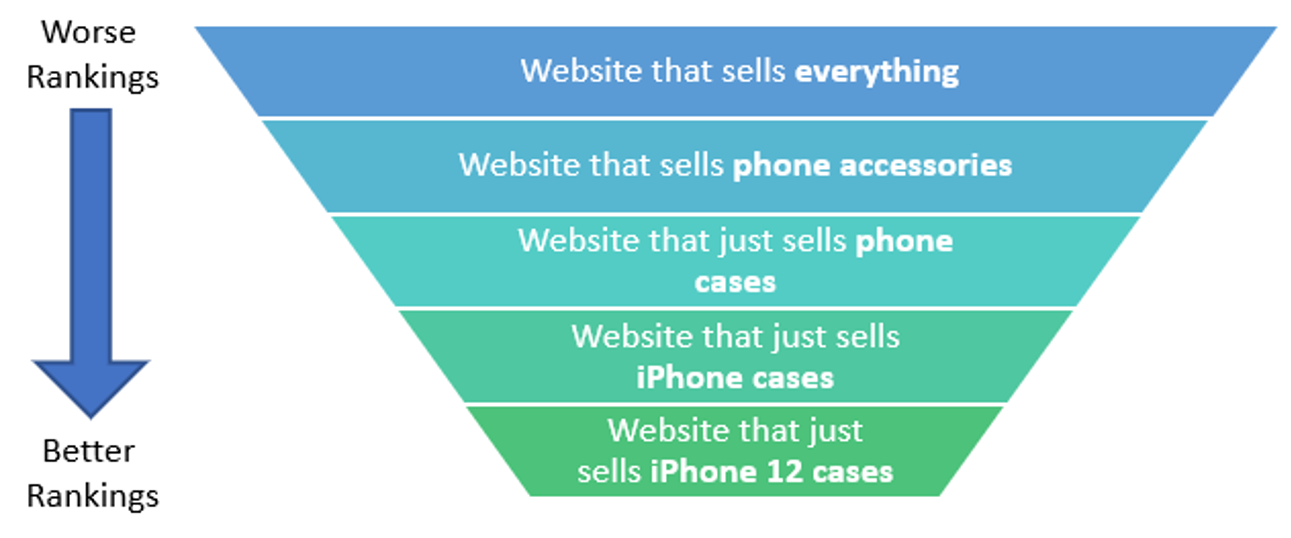
The more narrow and focused your catalog, the better your chances of ranking well for your core products.
One e-commerce site, WellBefore.com, took this concept to the extreme. Initially they had 7,500+ products across many health and wellness categories (first aid, bandaids, hand sanitizers, pain relief, etc).
But in reality, there were just a few core product lines that actually mattered to the business:: masks, gloves, COVID tests, and incontinence products.
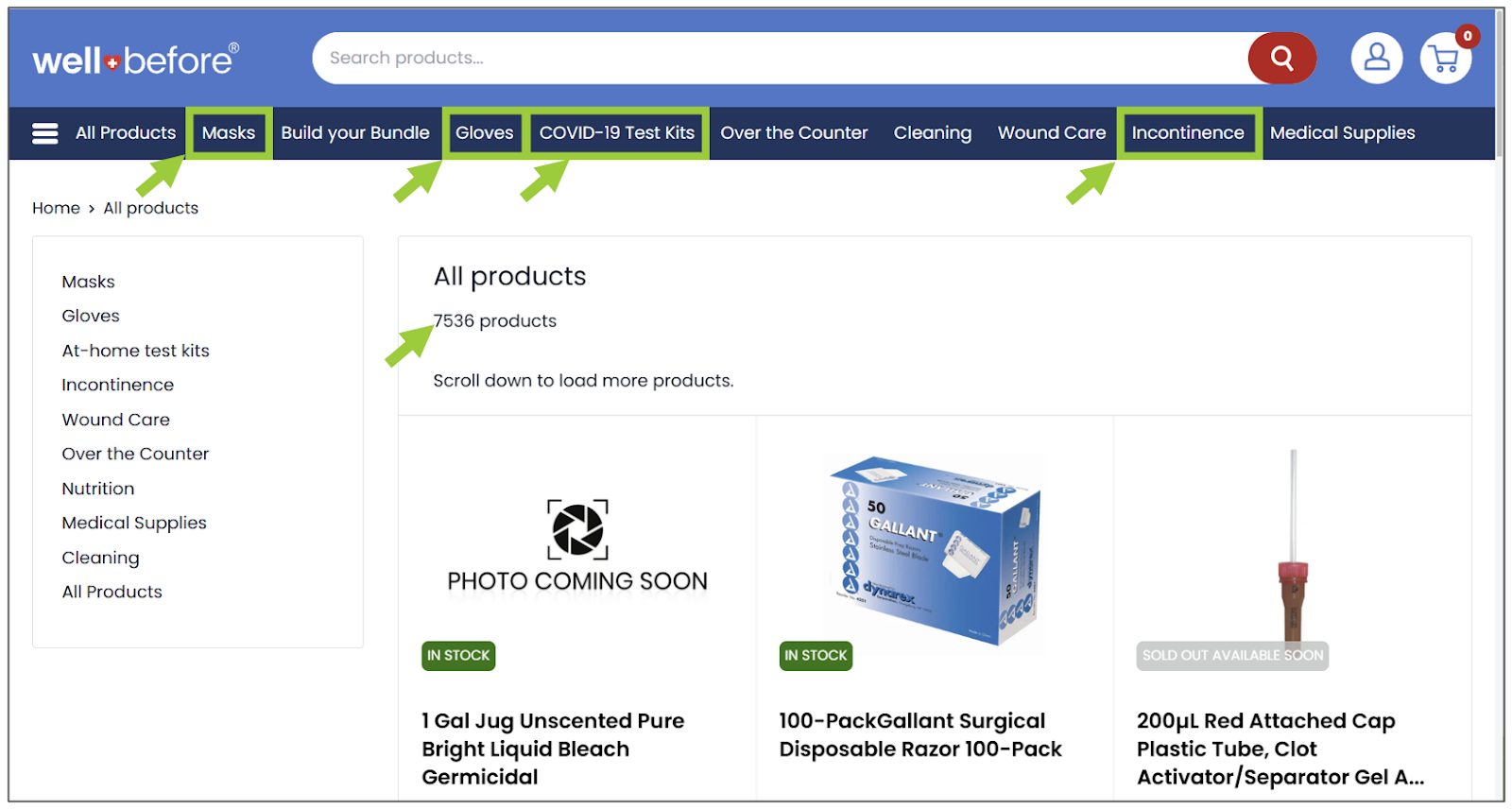
We worked together to no-index everything that was not in these core four categories, essentially removing 95% of their website pages from search engines.
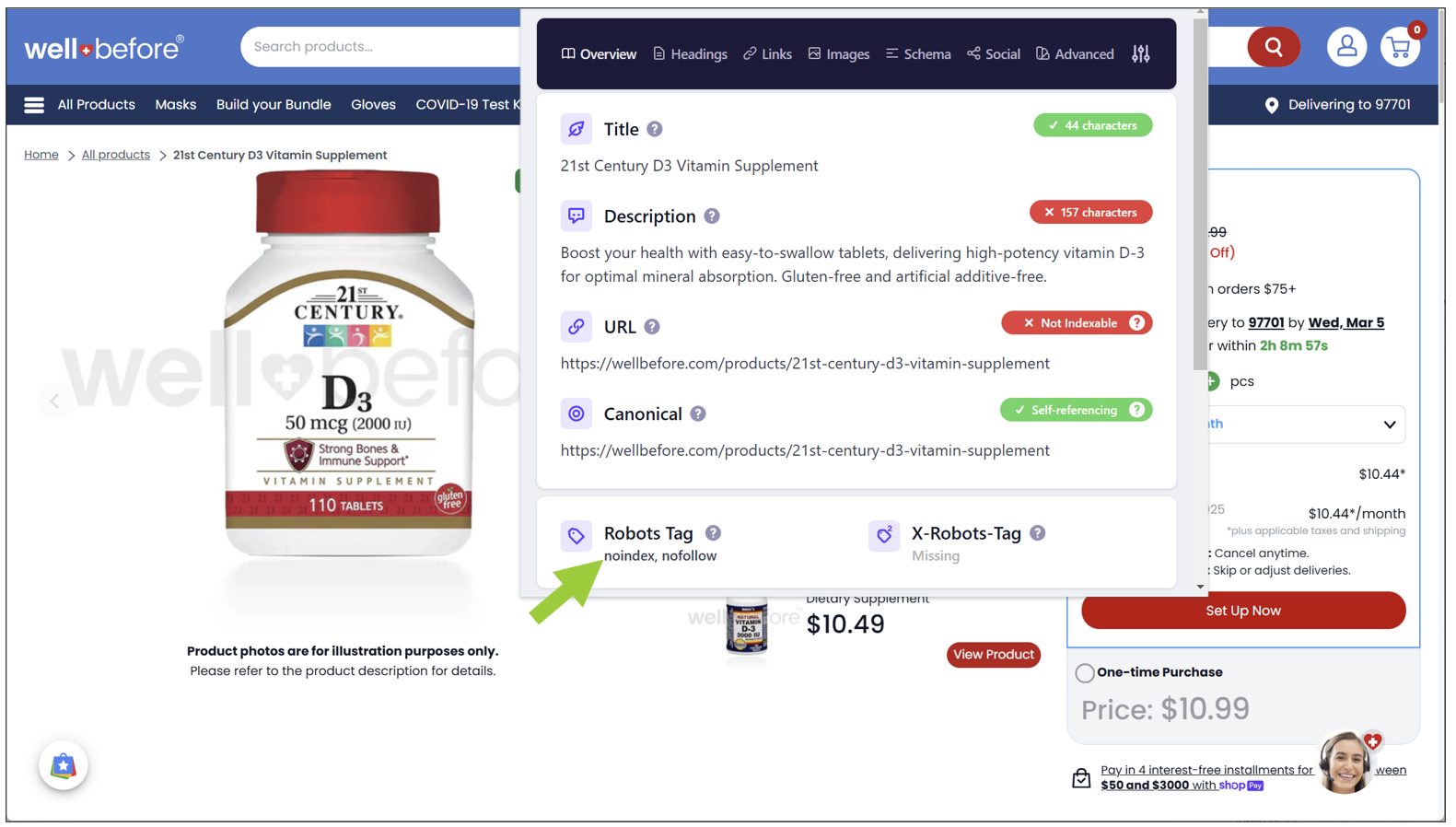
While this approach sounds counter-intuitive, the results were impressive—traffic for their core products doubled in just 30 days
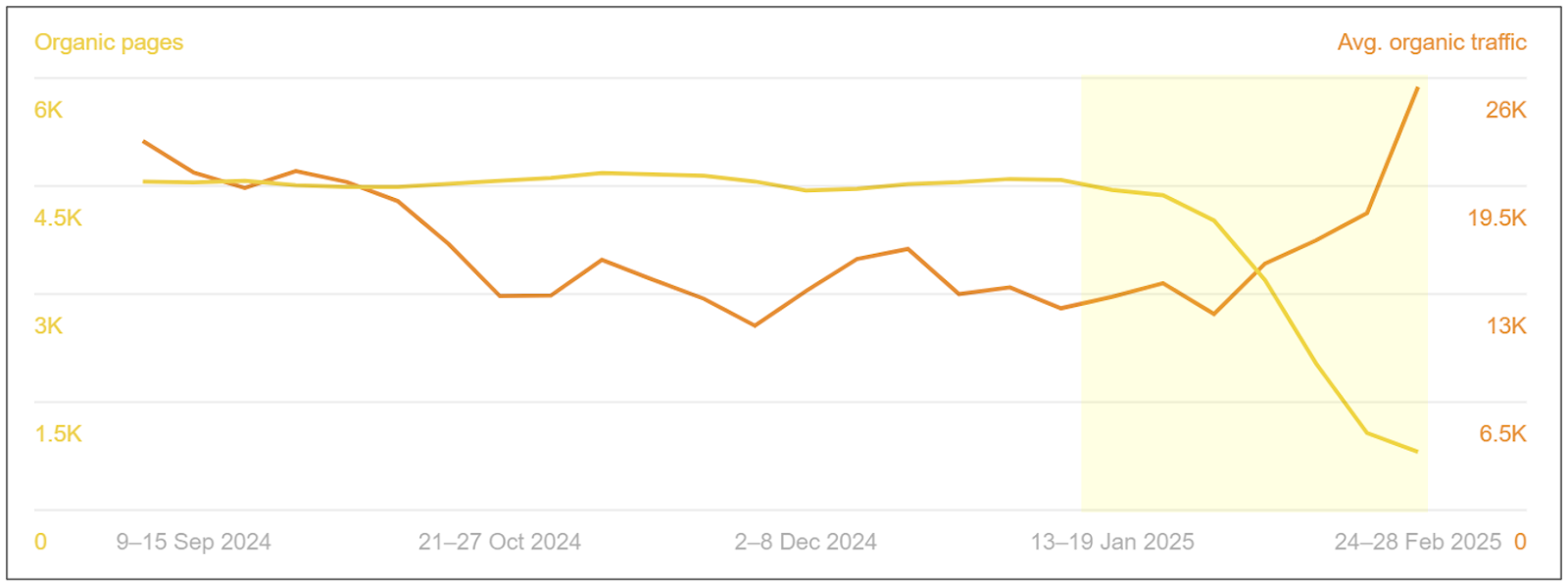
And their keyword rankings for many of their competitive terms shot up to page one.
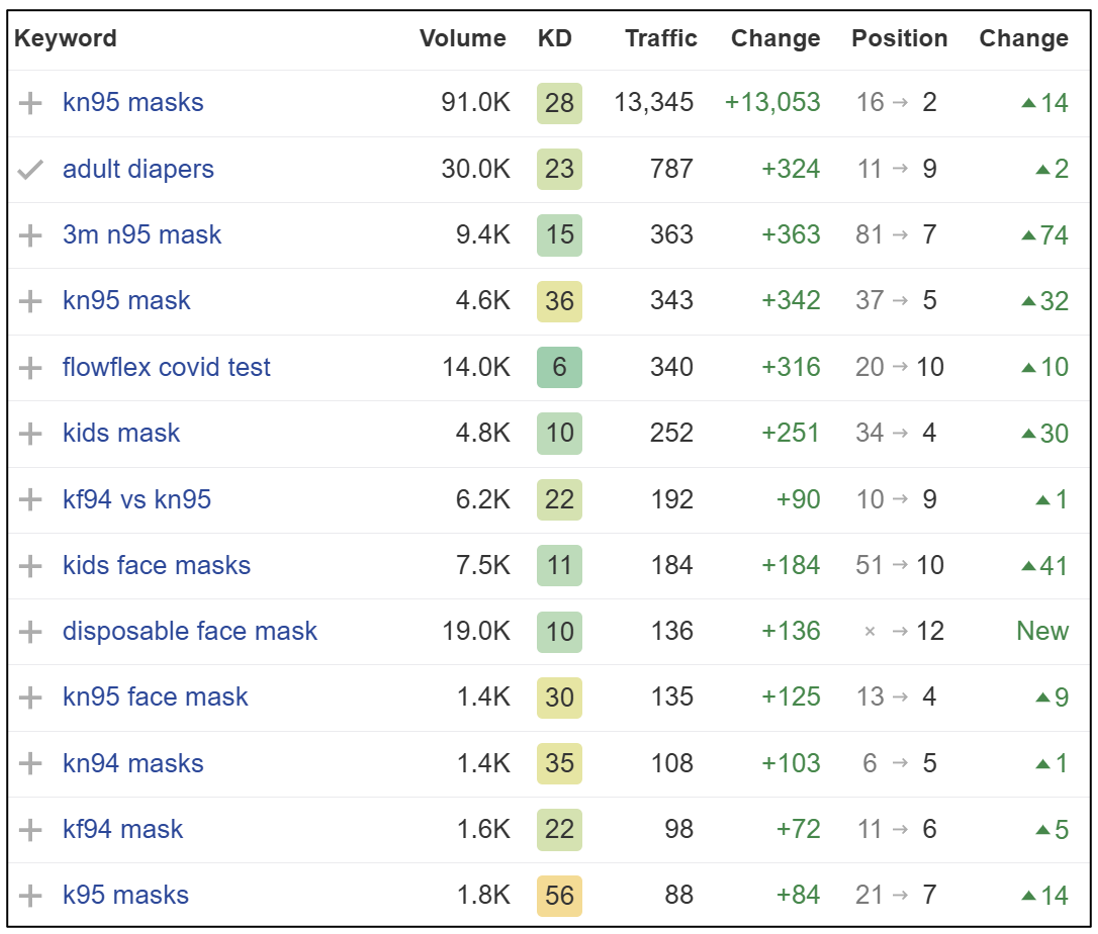
While I don’t recommend this extreme approach without professional consultation, it demonstrates how a more focused catalog can significantly improve rankings for your most important products.
Mistake #8: Trying to Rank the Wrong Type of Page
This often-overlooked issue can waste significant SEO resources.
Consider Himiway, an e-commerce site selling electric bikes. They wanted to rank for “electric mountain bikes” and focused their efforts on optimizing a product page for this term—building an impressive 78 backlinks to it over time.
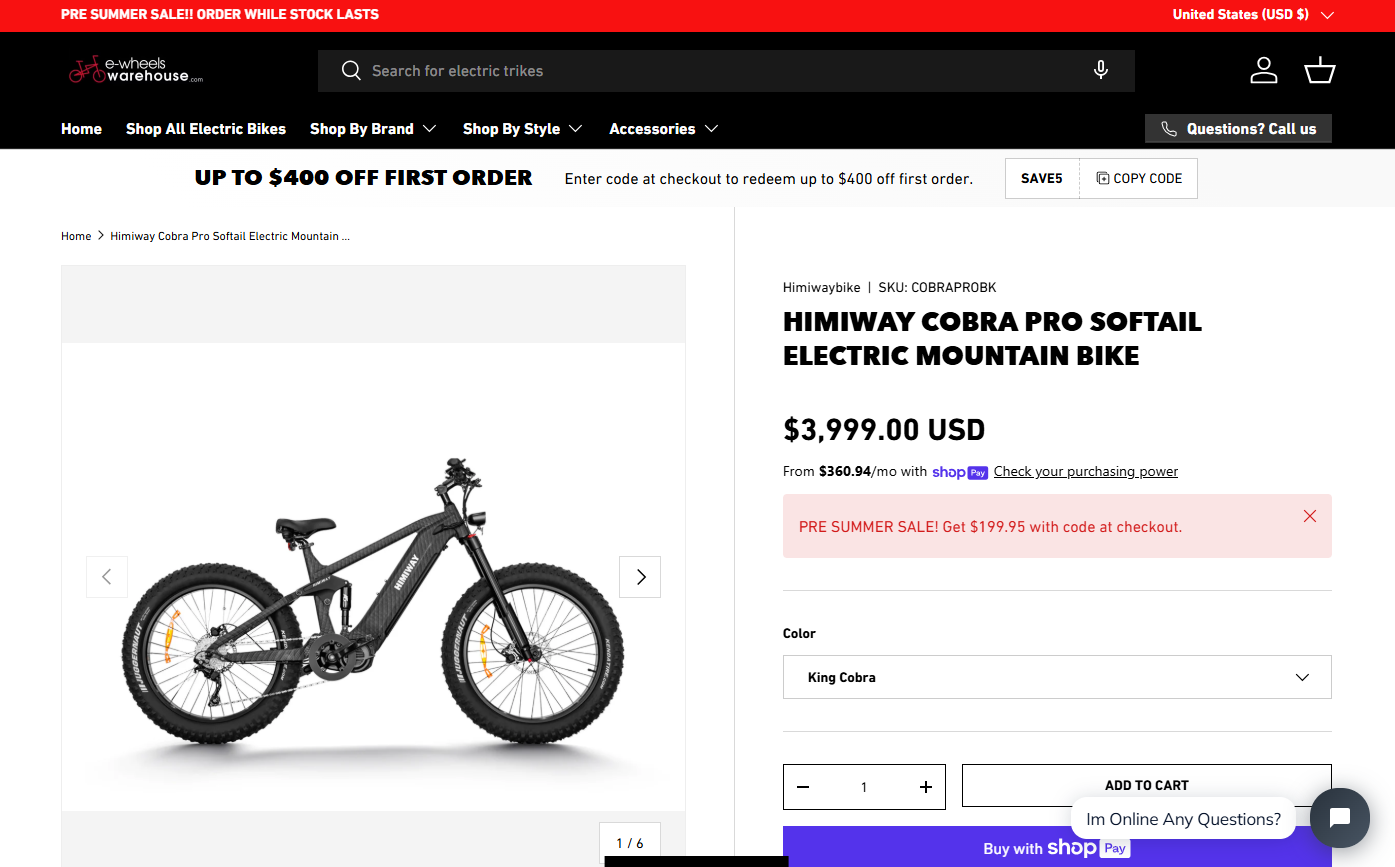
Despite these efforts, the page still ranked #41. Why? Because for this search term, Google overwhelmingly prefers category pages that list multiple products, rather than individual product pages.
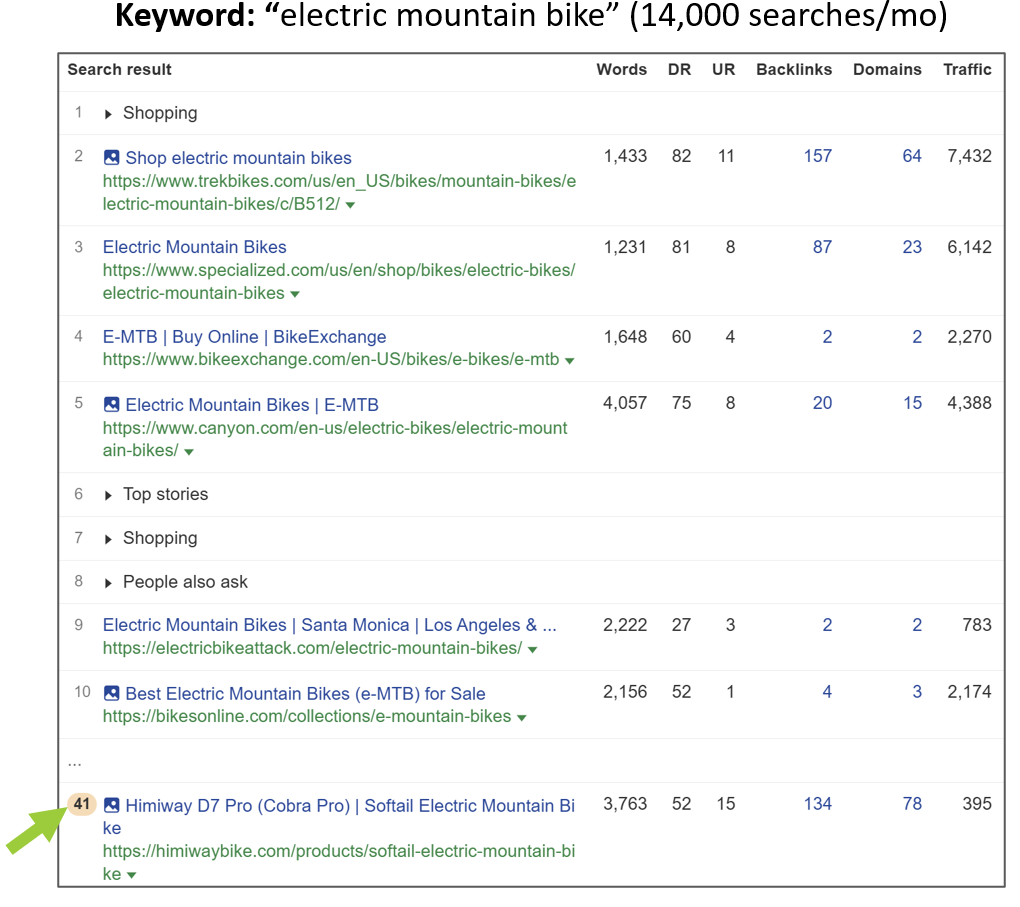
The top-ranking sites for this term (Trek, Specialized, BikeExchange, Canyon) all had category pages ranking on page one—not a single product page in sight.
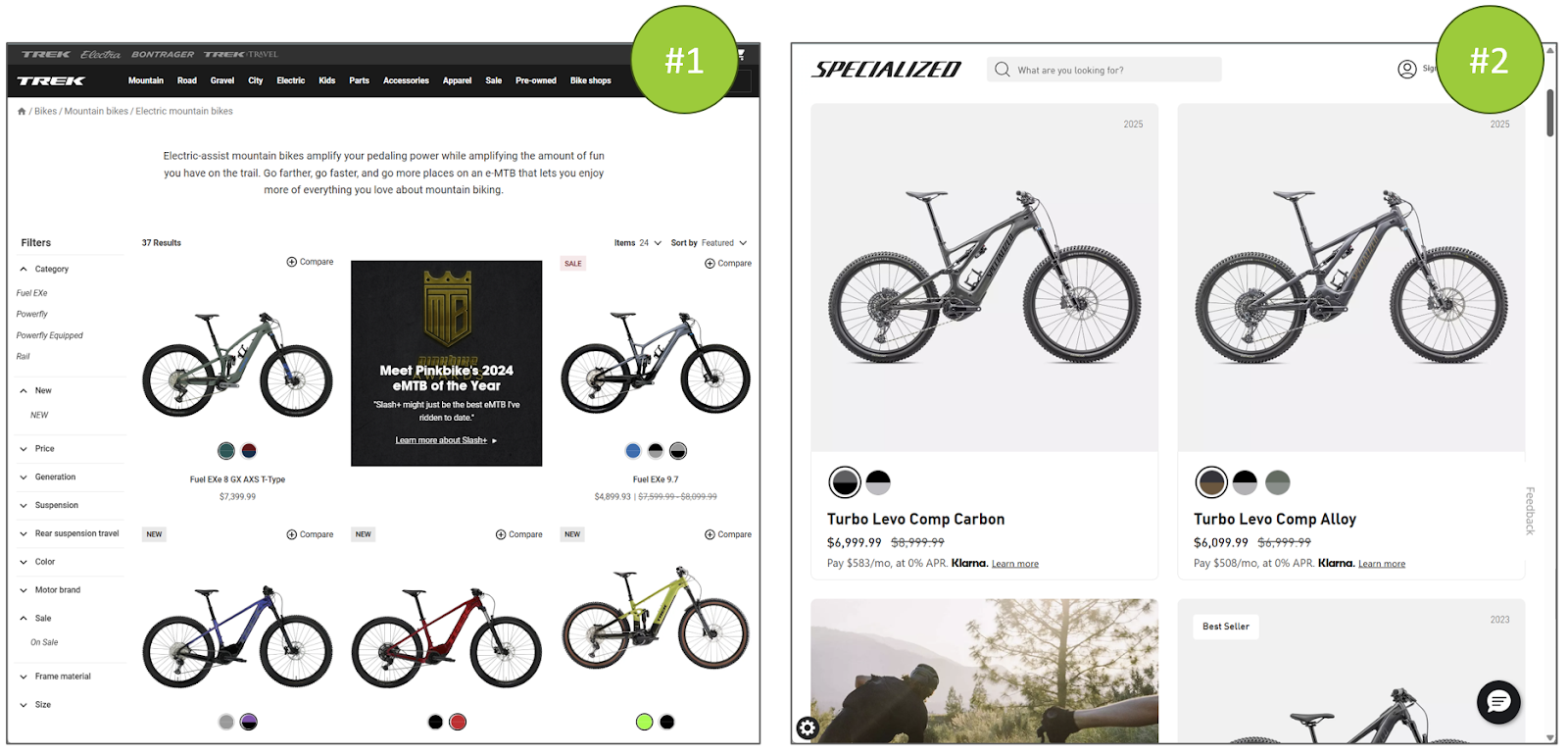
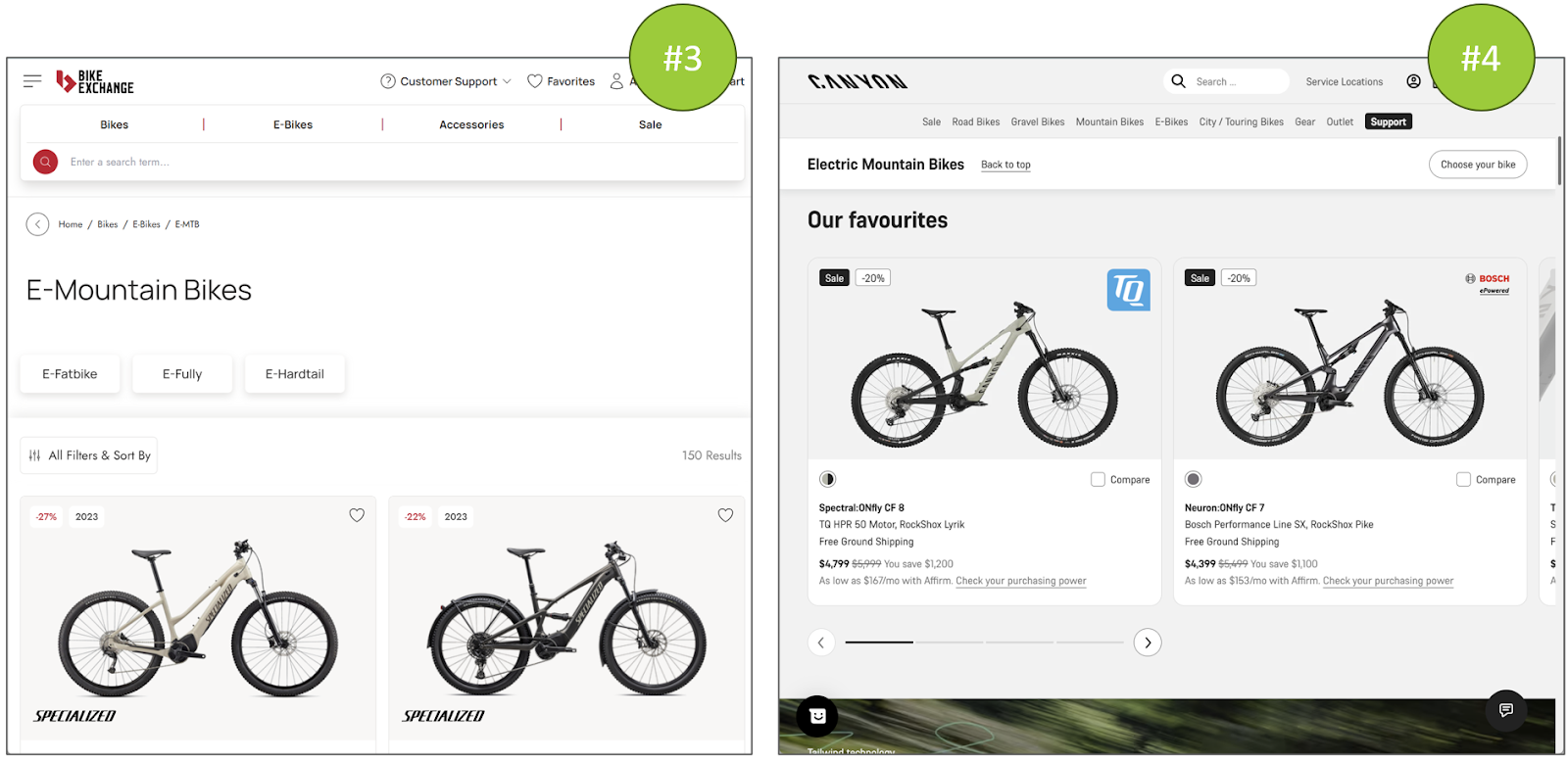
Meanwhile, Himiway’s electric mountain bike category page, which would have been the correct page to optimize, had only one backlink.
| Takeaway: Always search your keyword into Google to see what type of pages Google is already ranking for your target keywords. SEO is much easier when you go “with the grain”. If Google is ranking mostly category pages, push a category page. If it’s most product pages, push a product page. And if it’s mostly blog posts, then push a blog post. |
Mistake #9: Google Doesn’t Trust Your Website
Google evaluates website trustworthiness based on numerous factors outlined in their Quality Rater Guidelines. These guidelines help thousands of human quality raters assess websites for their expertise, authoritativeness, experience, and trustworthiness.
There’s a few tangible things you can do to improve your site’s trustworthiness:
- Display a phone number prominently (even if it’s just a recording that goes to voicemail)
- Show a physical address to establish legitimacy
- Maintain active social media profiles linked to your store
- Display third-party reviews from platforms like Shopper Approved, Yotpo, or Reseller Ratings
- Create a detailed About page that introduces your team
- Add author information to content with credentials and background
Wellness Verge exemplifies this approach. Every piece of content on their site identifies both the author and a credentialed reviewer, with detailed profiles available for each.
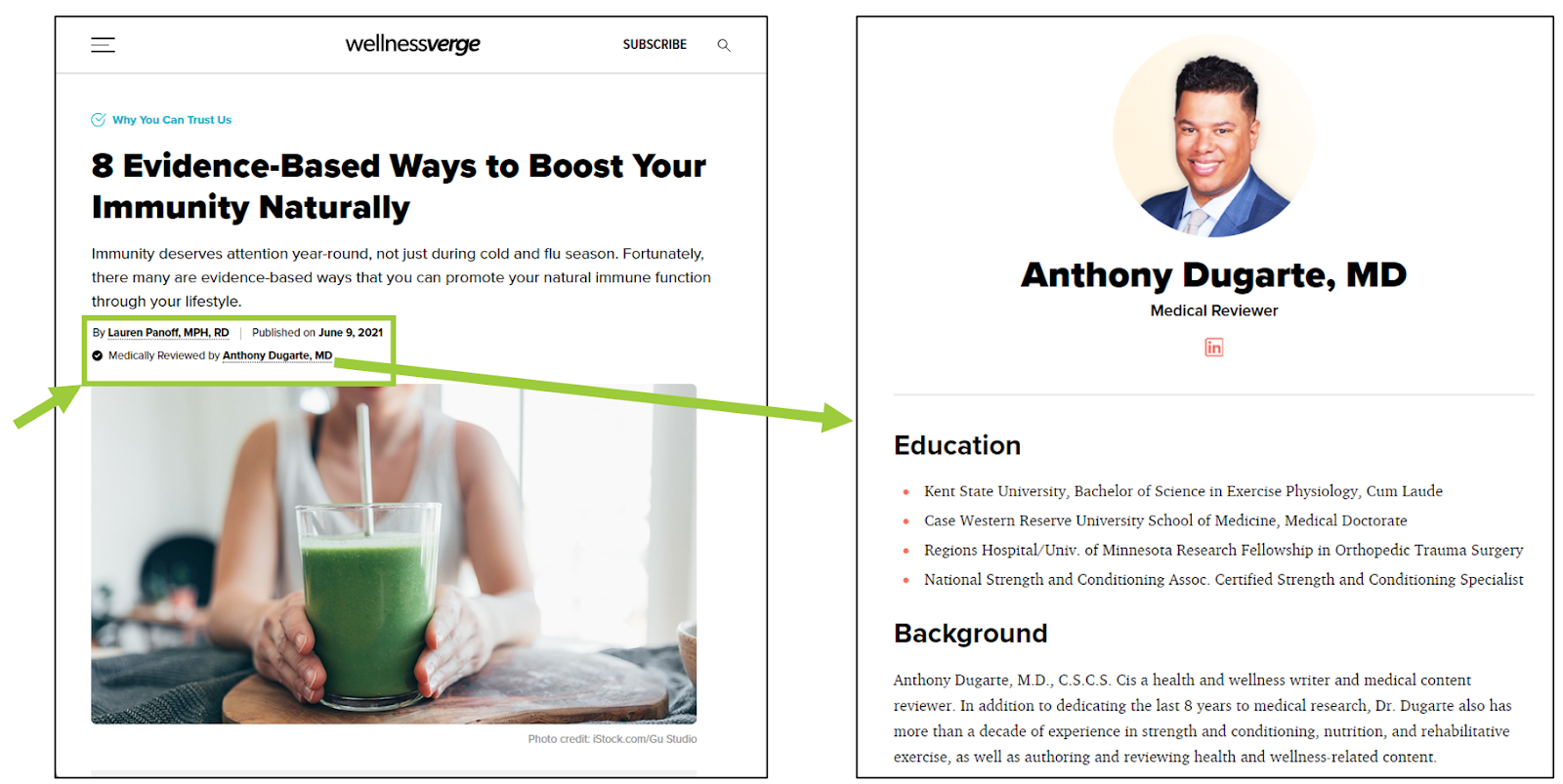
Mistake #10: Your Prices Are Too Expensive
Premium pricing can significantly impact your SEO performance—another factor rarely discussed in SEO circles.
Consider Keto Naturals selling premium dog food at $120 per bag.
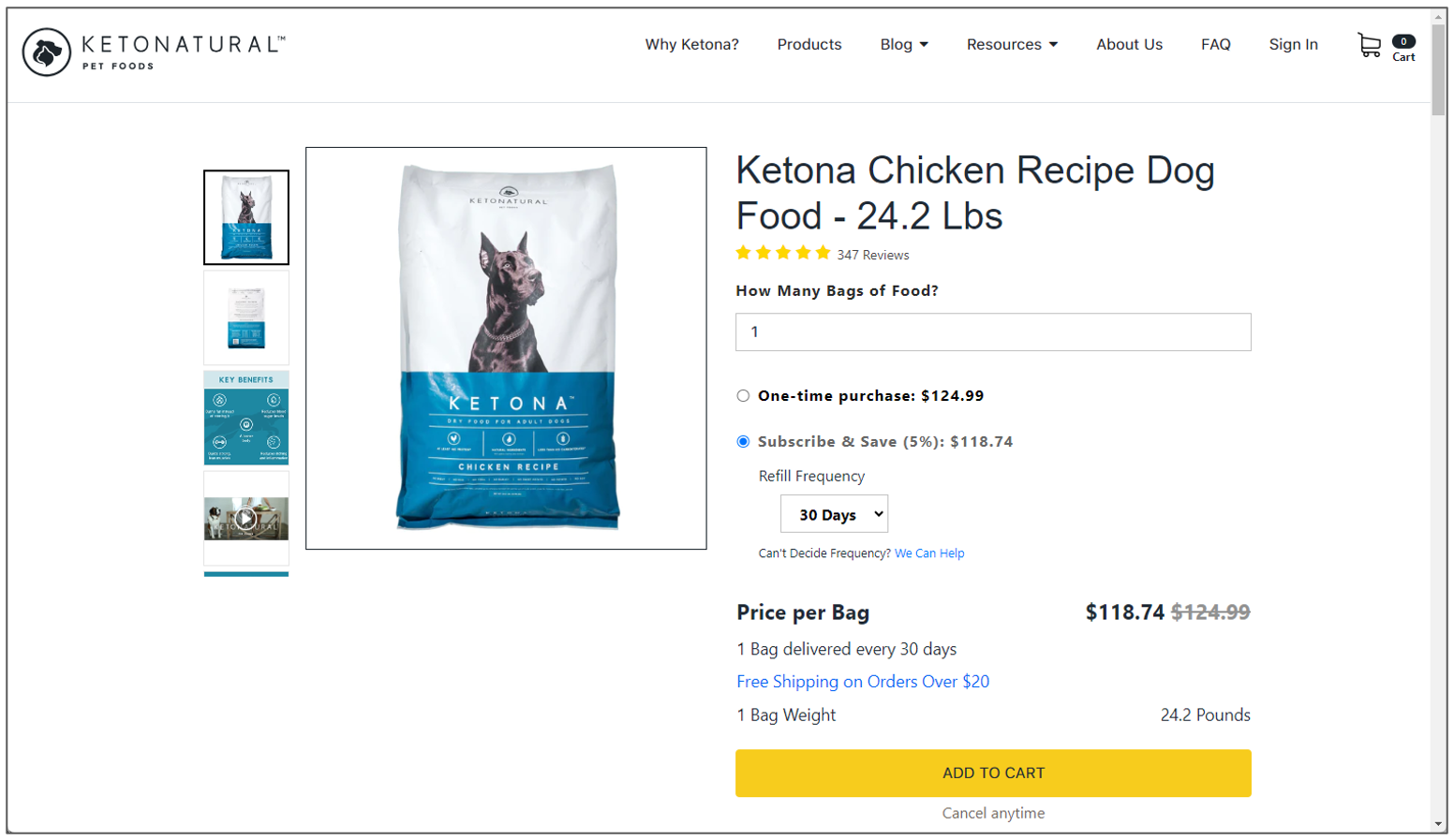
When we look at sites ranking on page one for “dog food,” we see lower cost product offerings products ranging between $30-60
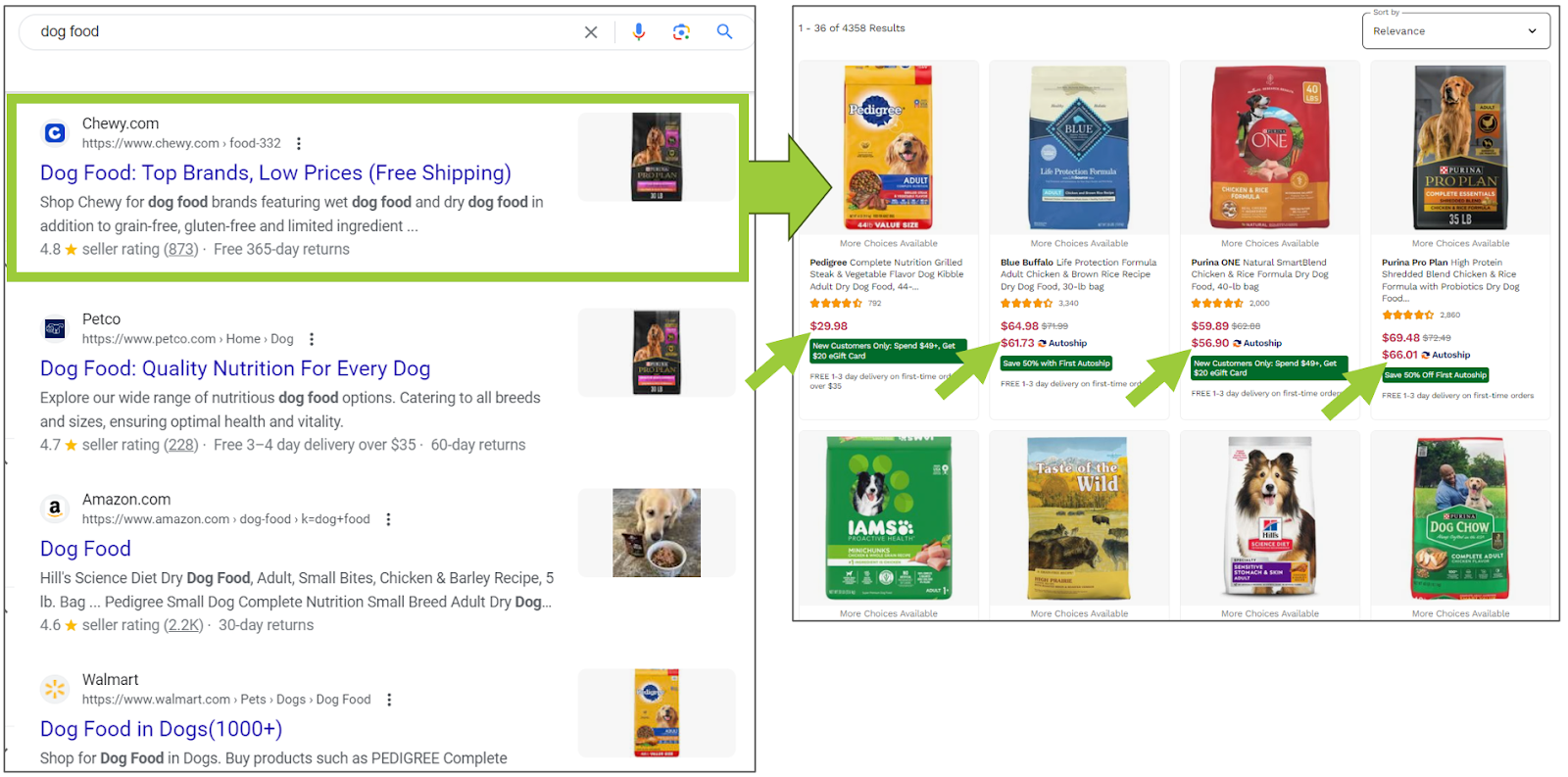
Why does this matter? The shopper distribution typically breaks down like this:
- 20 – 30% budget shoppers: looking for the cheapest option
- 50% value shoppers: willing to pay more for perceived value
- 10 – 20% premium shoppers: more affluent, seeking the best option regardless of price
If you’re selling premium products that only 20% of the market is interested in, there’s a good chance up to 80% of searchers who click on your site might immediately bounce back to search results to find a lower cost alternative.
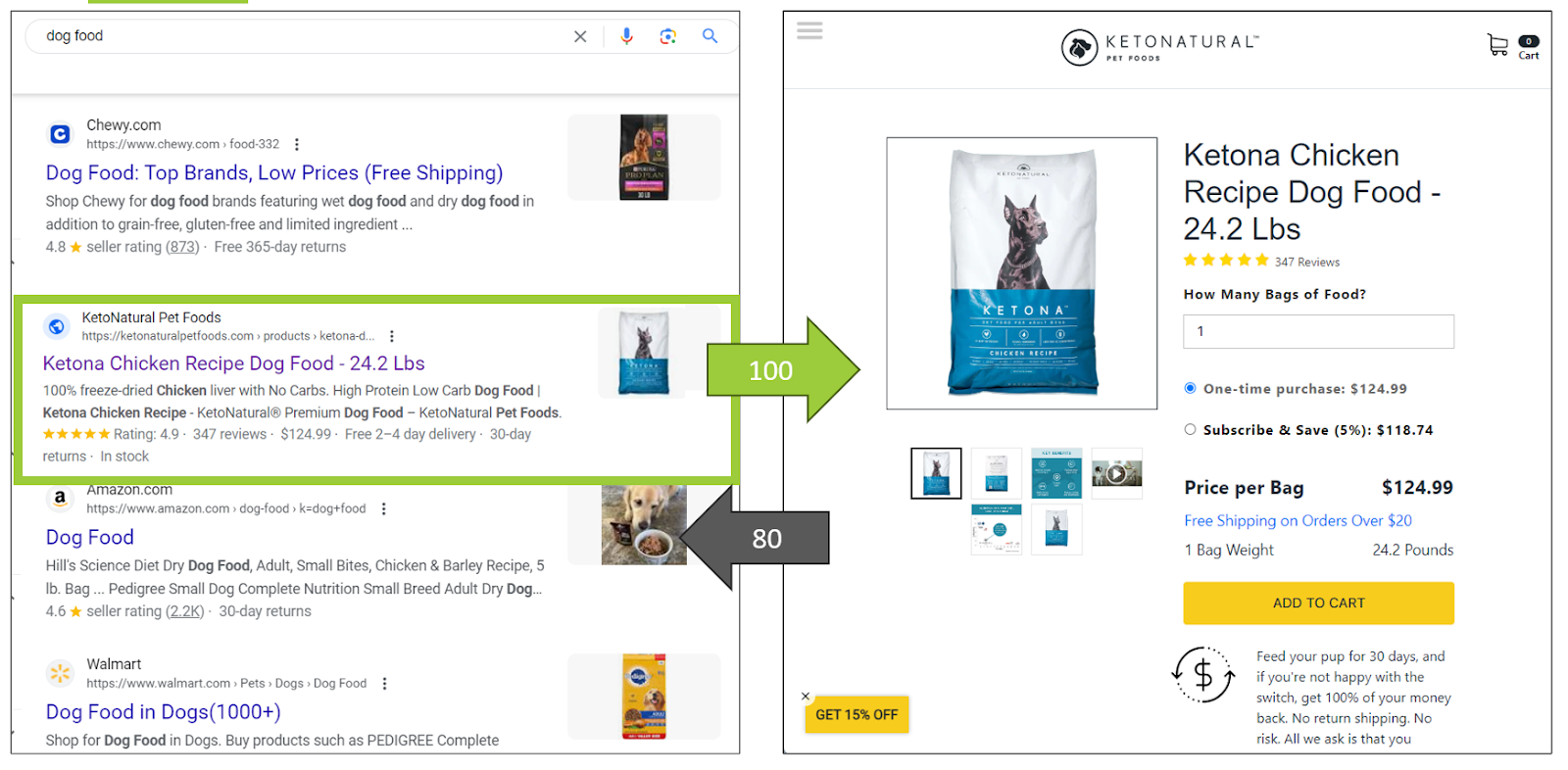
Google interprets this high bounce rate as a sign that your page isn’t satisfying user intent, eventually lowering your rankings. This makes SEO particularly challenging for premium brands with above-market pricing. While there are exceptions, SEO may not be the most effective channel for high-end products.
| Takeaway: It doesn’t matter how well optimized your page is, or how good your content is, or even how many backlinks you have. If Google sees a lot of searchers leaving your website and clicking back to the search results, you simply won’t rank very well. |
Mistake #11: Not Enough Backlinks to Your Pages
Even in 2025, backlink quantity and quality remain one of the strongest ranking factors in Google’s algorithm.
A comprehensive study by Backlinko analyzing nearly 12 million keywords found that:
- Pages ranking #1 had an average of 300 backlinks
- Pages ranking #2 had about 150 backlinks
- The number of backlinks consistently decreased as rankings dropped
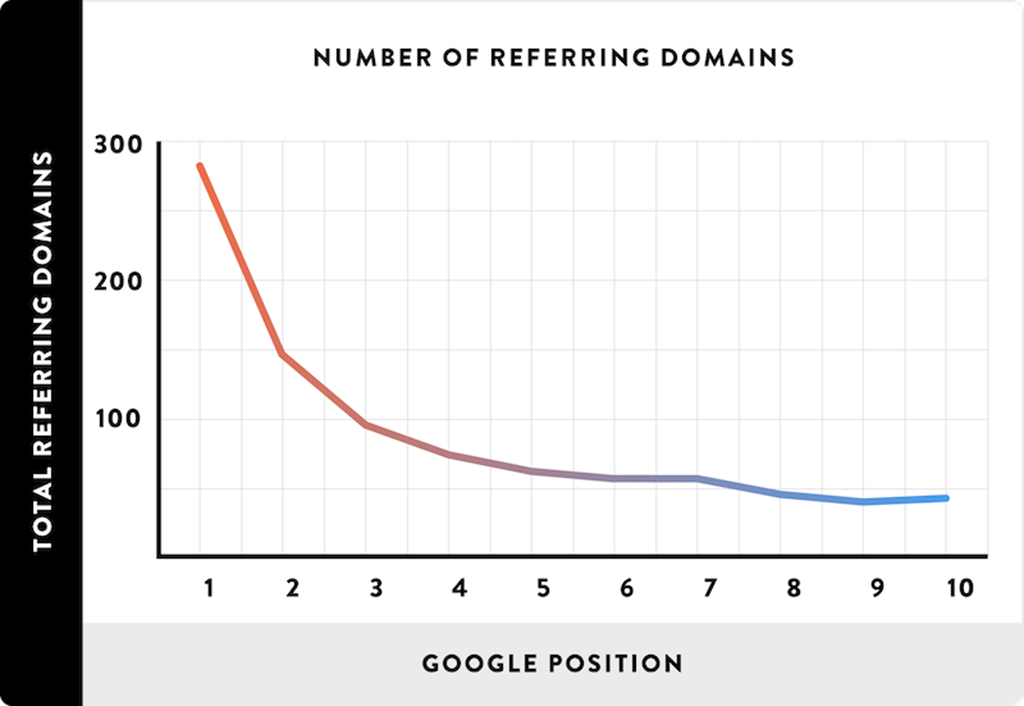
This correlation appears consistently across industries—as backlinks increase, traffic tends to follow the same trajectory.
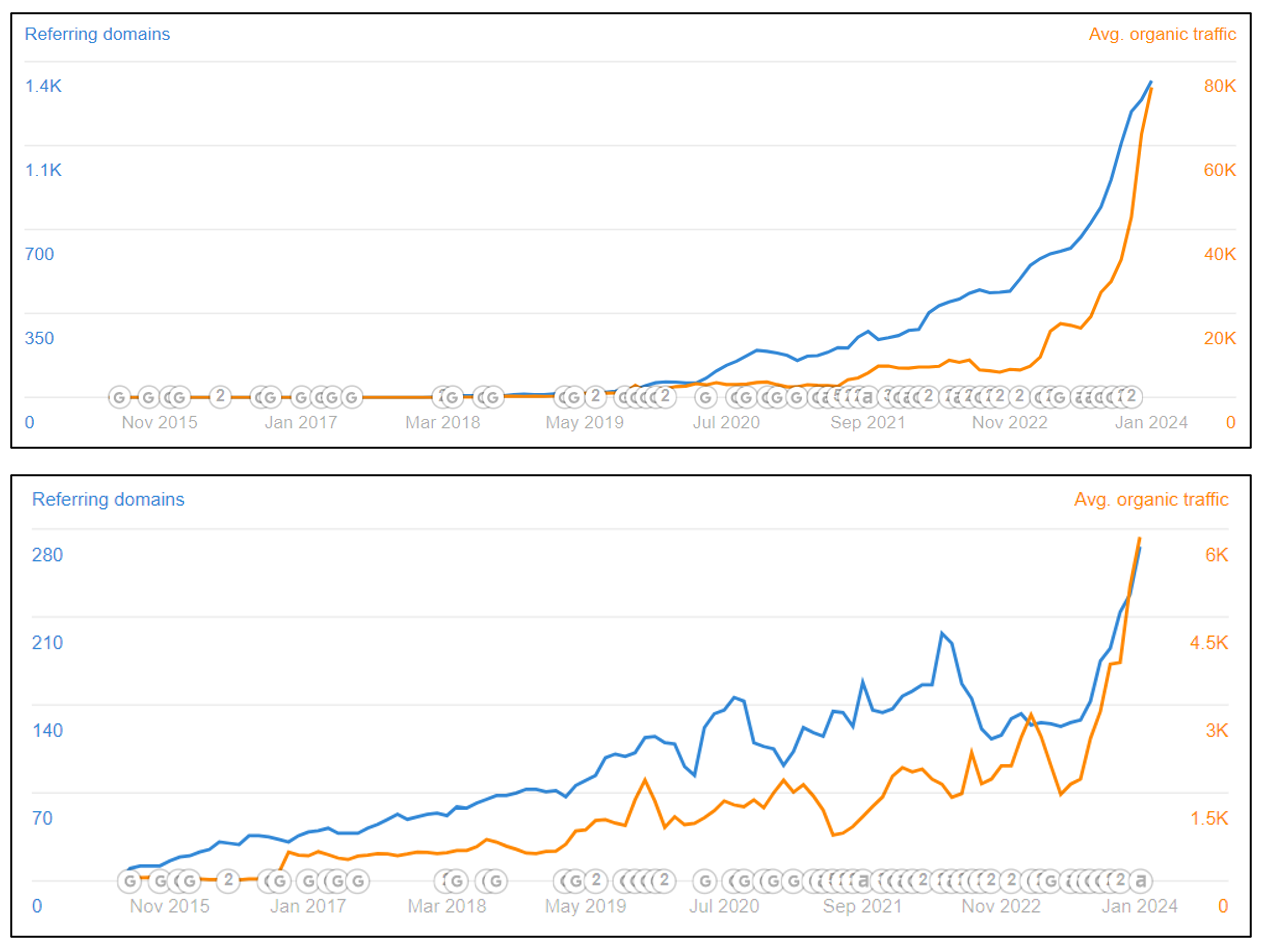
For example, the keyword “pink sunglasses” (7,600 monthly searches) shows that all top-ranking pages have between 1-3 backlinks. Meanwhile, brands like Blenders Eyewear and Forest Grant rank at the bottom of page one with zero backlinks.
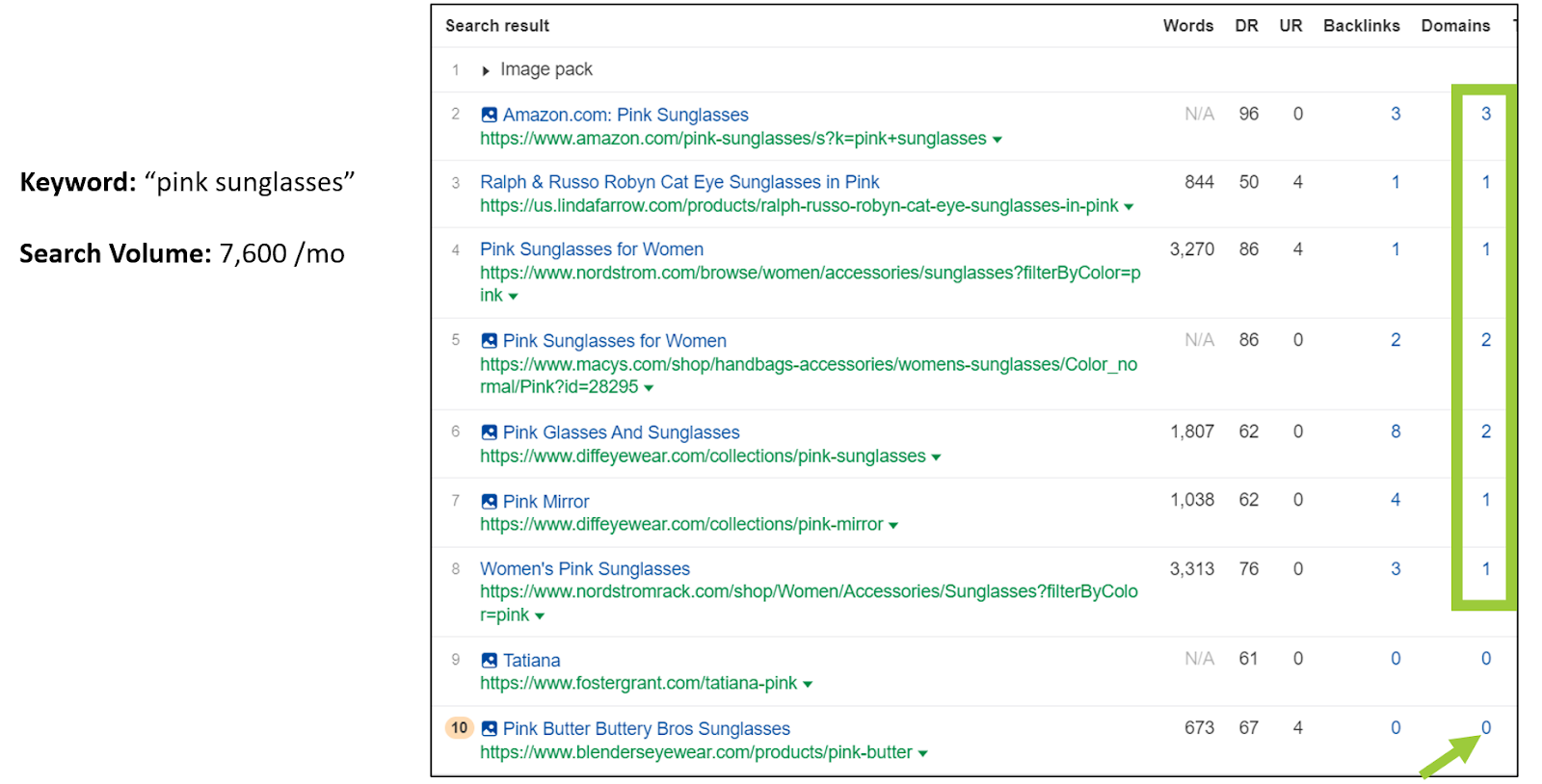
The good news is that for many long-tail category and product keywords, just 2-3 quality backlinks can be enough to achieve top positions. The key is ensuring you’re building backlinks to your most important product and category pages—not just your blog or homepage.
Final Thoughts
The SEO landscape for e-commerce has evolved significantly in recent years. By addressing these 11 critical mistakes, you can dramatically improve your store’s search visibility and revenue.
Remember:
- Focus on purchase-intent keywords
- Target less competitive terms first
- Add substantial, valuable content to category pages
- Use related keywords for context
- Provide genuine value, not fluff
- Fix keyword cannibalization issues
- Consider narrowing your product focus
- Optimize the right type of page
- Build trustworthiness signals
- Be aware of pricing challenges
- Prioritize quality backlinks to key pages
Implementing these changes won’t happen overnight, but the results can be transformative for your e-commerce business. Which of these mistakes will you tackle first?
